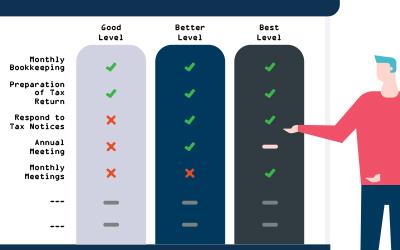by
L. Gary Boomer, CPA, CTIP, CGMA
| Jan 17, 2020
Since Amazon launched in 1994, it has grown from an online bookstore to one of the first places shoppers turn to buy everything from cleaning products to the latest tech gadgets. Their business model is “shop and then ship,” but as customers shop, Amazon is continuously acquiring data, enabling them to make recommendations based on their search habits. With the amount of data Amazon has gathered about its customers, they could almost transform their business model into “ship and then shop.
The business model of CPA firms is being transformed by technology as well. However, unlike Amazon, some firms aren't leveraging it. For decades, the CPA firm business model has been “effort determines value.” Now, we need to look for a more subjective value model that allows for different levels of service.
The case for subscription billing
Technology is the driving force behind the need for subscription billing. Technology has made several steps in the delivery of bookkeeping services redundant or of no value. Consider bank reconciliations and coding. That service used to take significant time and effort. But today most companies capture and code bank transactions digitally. There is little time or effort involved in reconciling bank accounts, and the service isn’t valuable. Tax preparation and audit sampling are going the same route, so technology is destroying the old business model for many CPA firms.
Meanwhile, consulting and advisory work doesn’t lend itself to pricing by the hour. If you try, you’ll wind up undercharging for the most valuable service you provide. Rather than giving away your knowledge, think of transactional and compliance work as a necessary add-on to advisory and consulting.
A few years ago, many firms offloaded bookkeeping by pushing it back on the client. In too many cases, when they received the books back for a tax or attest engagement, the books were inaccurate. The firm needed to make several adjustments to get the client’s records in order and perform the service they were engaged to do.
As firms shift to providing more consultative services, providing that service with inaccurate information is impossible. You need real-time, accurate numbers to consult. That’s why so many firms bring transactional work back in house and bundle it with compliance and higher-value consulting and advisory work.
Even in the best of times, pricing by the hour is difficult. Some services are more complex than others, so hours worked must be written up or down. The value of reconciling a bank statement is not the same as assisting with strategic planning or an acquisition.
Collecting fees is a challenge because, in many cases, invoices don’t reach the client until long after the firm completes the work and the invoice may be higher than the client expected. Most professionals have had the experience of working on a project that requires more hours or effort than initially quoted and figuring out how to add those additional hours to the bill.
Rather than charging clients after the work is done, why not charge a fixed monthly fee that covers the work you’ll perform for the whole year? In other words, give your clients a subscription.
Getting started with subscription pricing
Firms that charge by the hour for their services often wind up reacting to client
issues rather than proactively addressing their needs. This is because when a client wants to reach out to you for advice, they have no idea whether their problem is a 15-minute issue or a 15-hour issue. No matter how often you remind clients to call you before they make any major moves, they inevitably inform you of significant transactions after the fact.
As Ed Kless, Senior Director of Partner Development and Strategy at Sage, mentioned in his session on creating access-level agreements at the 2019 Boomer Technology Circles Summit, subscription pricing removes that perceived barrier to contacting you. Instead of putting out fires, you offer fire prevention.
Among firms that have been hesitant to transition to fixed-fee pricing, one of their main fears is agreeing to a fee, then winding up doing more work than initially agreed upon. With subscription pricing, instead of setting a flat fee and then dealing with scope creep, you establish levels of service and let the client decide what they want.
Step 1: Create service levels
Behavioral research1 around pricing indicates that having three options is simple for clients to understand, and it also anchors the conversation around the middle level rather than encouraging the cheapest option. Start by coming up with different levels of service you can offer your clients. For example, in a tax practice, you could offer the following three tiers.

Continue down the line, creating a list of all of the services you currently provide and others you don’t currently offer but would like to and are capable of delivering now. Avoid throwing in “fluff” that doesn’t provide value to your client.
Step 2: Set the price
Not every client wants or needs best-level service. Some are happy with good service. The key is, you’re not providing best-level service at a good-level price.
Some firms hesitate to price transparently because they’re afraid they’ll miss out on new business if they set their price too high. But you have to get comfortable with the knowledge that you can’t take all comers.
KPMG Spark is an example of a firm that is doing this very well. Currently, a cash-basis client with one to five bank accounts and a tax return can work with KPMG Spark for $320 per month. If the client wants to add payroll and consulting services, the price goes up from there. Some visitors to the website will decide that $320 per month is too expensive, and that’s fine. KPMG doesn’t want to do business with people who want to spend less than $320 per month for their services.
When setting your price, consider the following factors:
- Always retain your leverage. Price before the work is done.
- It takes no talent to lower the price, but it does take talent to increase the value.
- Pricing quickly will generally result in a lower price. Develop a deliberate pricing process. Plan the scope.
- Low prices demand low respect.
- The higher on the organizational chart you deal with, the less price-sensitive the person tends to be. People at the top do not have time to check out all options. They tend to have more resources and less time.
- Pricing for value requires confidence and courage.
- The presence of an undesirable option affects the behavior of the buyer by allowing them to choose among two desirable options. “Anchor pricing” has a halo effect on other offerings. Offer the highest option first and you will typically sell more of the middle option.
- A good price is one that is established for the client, not the service.
- Mutual gain (win/win) is not the same as equal gain.
- Price competition is only good for weak competitors.
- There is no way to value price the wrong client.
- Project, knowledge, and change management are more important than the number of hours spent on the job. Time is not a measure of value.
- Not all partners are created equal when it comes to pricing. Appoint a Chief Pricing Officer or pricing task force to ensure pricing is consistent across the firm.
Packaging and pricing services may seem like a complicated endeavor, but it can be broken down into simple, straightforward tasks. Take your time and focus on building out your subscription tiers and prices. Don’t be afraid of making a mistake. With each failure, you get closer to that perfect combination of service and price that’s a good fit for both your firm and your client.
 Gary Boomer is the Visionary and Strategist at Boomer Consulting, Inc. He is recognized in the accounting profession as the leading authority on technology and firm management and speaks around the globe on topics including strategic and technology planning; mindset, skillsets, and toolsets for the future; change management and developing a training and learning culture. You can contact him at lgboomer@boomer.com.
Gary Boomer is the Visionary and Strategist at Boomer Consulting, Inc. He is recognized in the accounting profession as the leading authority on technology and firm management and speaks around the globe on topics including strategic and technology planning; mindset, skillsets, and toolsets for the future; change management and developing a training and learning culture. You can contact him at lgboomer@boomer.com.
This article appeared in the winter 2020 issue of the Washington CPA Magazine. Read more here.
1 Ilan Mochari, Pricing and the Anchoring Effect, Inc., 2014, https://www.inc.com/the-build-network/the-anchoring-effect.html (November 2019)